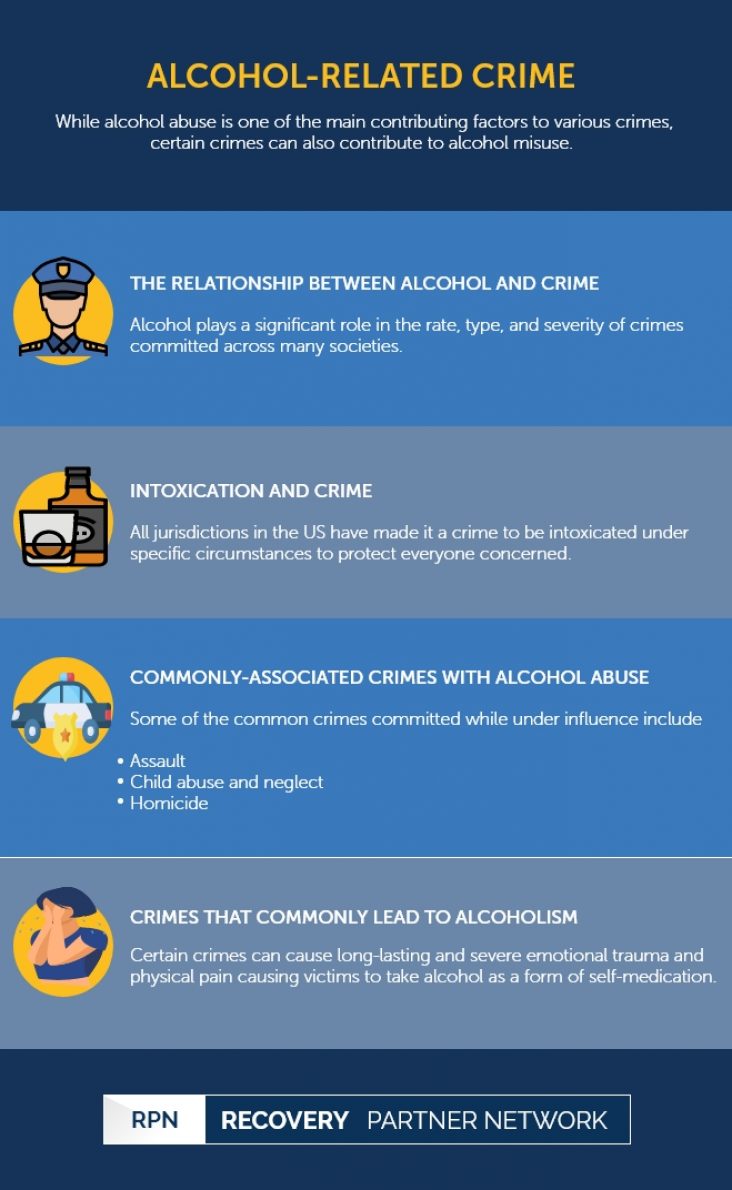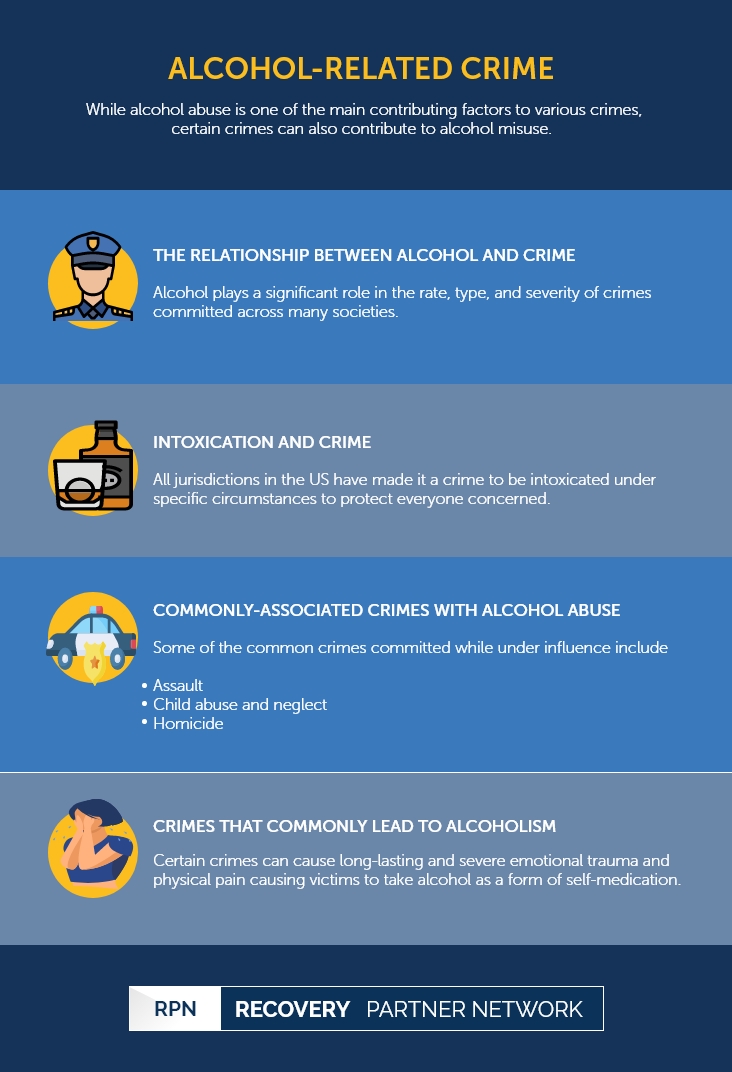While alcohol abuse is one of the main contributing factors to various crimes, certain crimes can also contribute to alcohol misuse.
Alcohol-Related Crime
Alcohol-Related Crime | Table of Contents
The Relationship Between Alcohol and Crime
Alcohol plays a significant role in the rate, type, and severity of crimes committed across many societies. The correlation between alcohol and crime can be divided into three primary categories, such as:
- Being intoxicated in inappropriate places and situations can be a crime. For example, driving under the influence (DUI) or appearing drunk in public.
- Since alcohol inhibits one’s judgment, individuals under the influence are highly likely to commit crimes such as assault or homicide.
- The victims of crimes such as child or sexual abuse are more likely to develop an alcohol use disorder later on in life.
FAQ
- What is the relationship between alcohol and crime?
- Why do some alcoholics get violent?
- Does alcohol increase anger?
- How many people die each year from alcohol?
The overconsumption of alcohol can lead to extremely dangerous situations that can develop into violence. The effects of alcohol can blur a person’s mental state, leading to an increased risk of committing violent crimes.
Alcohol abuse and the tendency to become violent may stem from a temperamental trait, such as a risk-seeking personality, or a social environment that encourages or contributes to violent behavior.
Alcohol doesn’t necessarily cause anger, but it can heighten pre-existing emotional distress and mental illness. In the case of individuals with temperamental personality, ongoing alcohol abuse may worsen the situation.
Studies show that 88,0005 individuals (approximately 62,000 men and 26,000 women) die each year in the United States from causes related to alcohol.
Intoxication and Crime
Alcohol influences or impairs an individual’s judgment, response time, actions, and level of aggression, which then places them and those around them in extreme danger of either physical or emotional trauma. As a deterrent, all jurisdictions in the US have made it a crime to be intoxicated under specific circumstances to protect everyone concerned.
Some of these circumstances are:
- Driving under the influence (DUI)/Driving while intoxicated (DWI)
- Minor In Possession (MIP)
- Public intoxication/Drunk in public
- Open container
Driving a motor vehicle while intoxicated can be extremely dangerous or fatal. The inability to react quickly or stay focused while driving under the influence can result in dire consequences for everyone involved. DUI can result in fines or jail time, depending on the severity of the circumstances.
Alcohol imposes adverse effects on the developing brains of children and teenagers that can result in life long consequences. Since children and teenagers do not have the mental, emotional, and physical maturity to manage intoxication and its effects, most jurisdictions across the US have established the legal drinking age as 21, while a few jurisdictions have set it to 18. Consequently, it is a crime for anyone younger than the stated age to possess alcohol. MIP offenses are quite common in college towns.
Intoxication often makes an individual sound loud, aggressive, belligerent, and disruptive, causing serious disturbances to those around. Thus, most jurisdictions limit alcohol use to specific places such as restaurants, homes, and bars. This makes it illegal to be visibly intoxicated in public places. Nevertheless, public intoxication is quite problematic to prove from a legal perspective, and most jurisdictions use this legal clause to evacuate belligerent drunkards from public places and sequester them in a jail cell until sober.
Since public intoxication can be quite difficult to prove from a legal perspective or to prevent individuals from getting intoxicated in public, many jurisdictions have made it illegal to possess an open alcohol container. However, the open container law has the least severe penalties of all intoxication crimes.
Commonly-Associated Crimes with Alcohol Abuse
Alcohol can severely impair an individual’s judgment, causing them to behave or act in ways that are uncharacteristic of their sober personality. Alcohol also makes individuals vulnerable enough to be taken advantage of and victimized. The consequences of alcohol often magnify when there are other intoxicated individuals present, as they tend to provoke or antagonize each other into committing crimes.
Some of the common crimes committed while under the influence are:
- Assault
- Intimate partner violence (IPV)
- Child abuse and neglect
- Homicide
- Sexual assault
- Burglary and robbery
Since alcohol increases aggression and irritability and decreases impulse control, intoxicated individuals are highly likely to partake in violence. Assaults, verbal or physical threats are the most commonly associated crime with alcohol. Studies have found that around 25 to 50 percent of assaults are caused by alcohol intoxication.
Also known as domestic violence, it is the act of causing emotional, physical, or sexual harm to your partner. Numerous studies have discovered a close correlation between intimate partner violence and alcohol abuse.
Experts believe that alcohol abuse leads to domestic violence in the following ways:
- Alcohol affects physical and cognitive functions, reducing self-control and rendering an individual incapable of handling non-violent arguments and conflicts in a relationship.
- The excessive alcohol consumption of one partner can result in financial difficulties, childcare issues, or other family stressors. This can cause tensions and conflicts between partners that can lead to violence.
- The popular belief and acceptance of alcohol inciting aggression can encourage individuals to use it as an excuse for violent behaviors.
Similar to assaults and intimate partner violence, alcohol causes individuals under the influence to commit acts of violence and abuse against children. Almost 40 percent of child abusers confessed to being under the influence of alcohol while committing the heinous crime. The high costs of maintaining an addiction combined with professional consequences such as job loss due to alcoholism can also cause parents to neglect their children. Parents with a severe addiction to alcohol can also create an unsafe environment for their children to be preyed upon.
Alcohol is the cause of many homicides. About 40 percent of convicted murderers were reportedly under the influence of alcohol while committing the horrible act. Alcohol does not only make crimes more likely, but it also amplifies the severity of such acts. Alcohol can also increase recklessness, leading to negligent homicide, which may occur accidentally due to the individual’s action or inaction. Homicides involve the most severe penalties of any crime involving intoxication.
Any unwelcome, forced, or non-consensual sexual act, including kissing, touching, and intercourse, is regarded as sexual assault. Although sexual assault is most commonly committed by men against women, perpetrators of sexual assault can be a person of any gender. Around 30 to 40 percent of reported sexual assaults, including rapes, were committed by individuals under the influence of alcohol. It is highly likely for this percentage to be much higher, considering that a large number of sexual assaults go unreported. Alcohol is also used by sexual predators to render their victims unconscious or incapable of resisting any sexual advances. Sexual offenders may also use alcohol as an excuse for their unwarranted actions or to convince the victims that the assault never happened or was consensual.
Many resources have discovered that:
- About 72 percent of sexual assaults in colleges happened to victims who were overly intoxicated.
- Almost 88 percent of men who committed rape at colleges were under the influence of alcohol.
- Sexual assaults are nineteen times more likely to happen on days or situations where the victims or perpetrators consume four or more alcoholic drinks.
Alcohol abuse can be the prime reason for an individual to face financial difficulties. The high costs of maintaining the addiction can soon push an individual to the brink of bankruptcy. Thus, in order to meet daily needs and to continue the addiction, an individual may opt to take part in illegal activities such as stealing. About 15 percent of robberies in the US have been related to alcohol abuse. Nevertheless, the legal consequences of robbing someone are often severe and may include jail time, criminal charges, or fines.
Crimes that Commonly Lead to Alcoholism
Certain crimes can leave victims with long-lasting and severe emotional and mental trauma. These traumas can sometimes be so overwhelming that they could cause the development of anxiety, low self-esteem, depression, and post-traumatic stress disorders (PTSD) in victims. Individuals suffering from these conditions often turn to alcohol as a means of forgetting or escaping. Some crimes may inflict permanent, painful physical injuries, causing victims to take alcohol as a painkiller. However, this cycle of alcohol abuse can soon transition into severe addiction or dependence.
Victims of the crimes stated below are highly likely to abuse alcohol:
- Child abuse and neglect
- Sexual assault
- Physical and emotional abuse
- Mugging
- Domestic violence
Victims are further victimized when they chose to self medicate through alcohol, as alcohol abuse can further exacerbate the psychological distress experienced by the victims. It is vital that victims of such crimes seek help and therapy through counseling before the situation intensifies.
Recovery Partner Network
We aim to educate and empower. If you feel our library of resources does not cover your specific need, reach out to us, and we would be happy to help.
STATISTICS
© Copyright 2025


